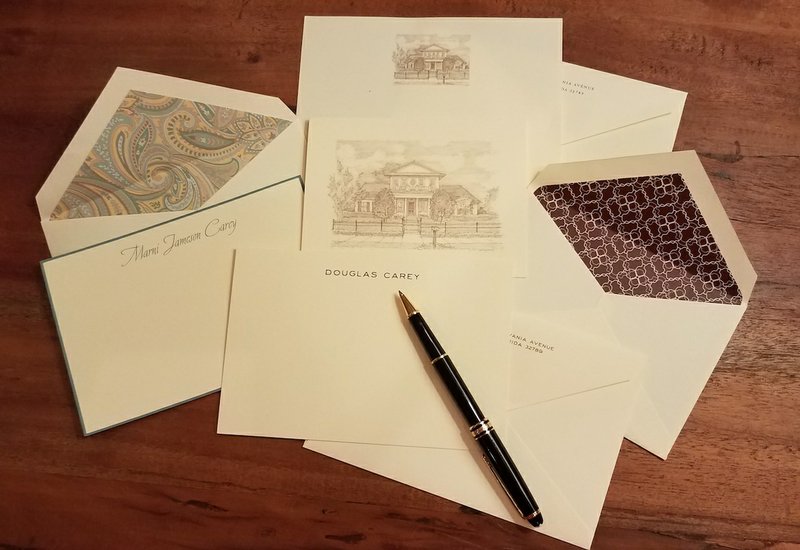"What do you want for your birthday?" my brother asked. This is the same brother who once suggested my parents give me to a couple who couldn't have children. Our relationship has improved.
I had zippo ideas. Don't tell DC this, but I don't need anything. In fact, I need a little less. But then a gift idea occurred, one that would cost my brother nothing but time, and that only he could give.
"Would you draw a picture of my house?" I asked.
My architect brother is an excellent artist.
"And sign it?" I added.
He did not say yes, but that has never stopped me. I emailed him a picture of the Happier Yellow House.
The envelope arrived two weeks later. I opened it, and an unexpected spurt of tears made the art impossible to see. I swatted them away, wondering what had come over me. Eventually, my eyes cleared, and my house emerged, as if through a fog, a gift that, for so many reasons, moved me more than any store-bought gift could. Then I realized what my heart had known before I did.
After years of writing and thinking about home, and decades of living in houses that I'd built or renovated, that I was fixing to sell or fixing to leave, that were too big or too small, that I staged to help others sell -- a four-year-six-house period during which the most stable part of my life was a PO Box -- the house on the page, drawn in my brother's hand, is where I am finally, profoundly, and happily -- insert a collective yoga breath here -- home.
Enough blathering. What I'm leading up to is, for the first time in forever, I have a home address that is as permanent as any can be. Which means I can have stationery printed. And I know just what image to use.
I also know just whom to ask. My neighbor Ellen Prague owned and ran The Paper Shop, a chic stationery store, for almost 40 years. She recently closed the shop but still sees clients there by appointment. She is the queen of correspondence. I told her about the drawing, and asked if it would work for note cards.
"Not only would it work," she said, "but I also love the idea of it being part of your home's stationery wardrobe."
"Your home's stationery is your connection to society," she said. "It's your home's handshake to the world, an extension that says my home is part of the community. It's simply part of gracious living."
I have some catching up to do.
A home stationery wardrobe includes personalized letter sheets, correspondence cards (for short notes), and folded note cards, all with matching printed envelopes, she said. Then, using the house drawing as a starting point, Prague helped me build my home's stationery wardrobe. Here's how she says to build yours:
• Decide your purpose. Will you use the stationery for bread-and-butter notes (thanking others for their hospitality), or professional communications? Correspondence cards are easiest to use, and are most common today. The folded note is more traditional, and provides a bit more room to write. Letter sheets with the house address are a correspondence staple, and can also work in a guest room for visitors to use.
• Pick your paper. You can't go wrong with white or ivory, by far the most common stock colors. "Some like the crispness of white; others feel that ivory is softer, and more elegant," she said. Occasionally, someone prefers a pastel. Feel the stock to make sure you like its weight and texture.
• Think about ink. Your ink choice will affect look and price. Flat digital printing means the ink dries flat on the paper. Thermography results in raised lettering. Engraving (the most expensive) actually presses the ink into paper, leaving a mark on the flip side. "If you really want to make an impression go with engraved," Prague said. Pick an ink color that goes with your house and personality.
• Find your font. First, decide if you want straight type, which is more tailored, or script, which feels fancier. Then choose a readable typeface that suits your style: pretty or playful, edgy or elegant, casual or corporate.
• Spell it out. Write out what copy should be printed where, including on envelope flaps. Don't abbreviate any words. Always get a proof.
• Personalize it. On correspondence cards, Prague recommends using your name, spelled out, no initials. Cards should only have one person's name, (so not Sue and John Jones). "One person holds the pen," she said. She likes putting monograms on folded notes, or images, such as a family crest. If you live on a street called Hummingbird Lane, consider a birdhouse graphic. For our wardrobe's folded cards and letter sheets, we had the house drawing printed in Kona brown ink on ivory stock. For my correspondence card, I chose a feminine script in peacock blue. For DC's, we picked masculine block lettering printed in Kona.
• Add some flair. If you're not completely overwhelmed by this point, consider adding a flourish like a border, a graphic embellishment, or an envelope liner, which comes indozens of colors and patterns.
• Order in person. Though ordering stationery online is an option, working with a stationery consultant is worth it. Prague and I spent well over an hour fine-tuning my order.
When my order arrived opened the boxes and thought: I'm home, and, what's more, I might even have arrived.
Syndicated columnist Marni Jameson is the author of five home and lifestyle books, including Downsizing the Family Home — What to Save, What to Let Go.
HomeStyle on 06/15/2019
